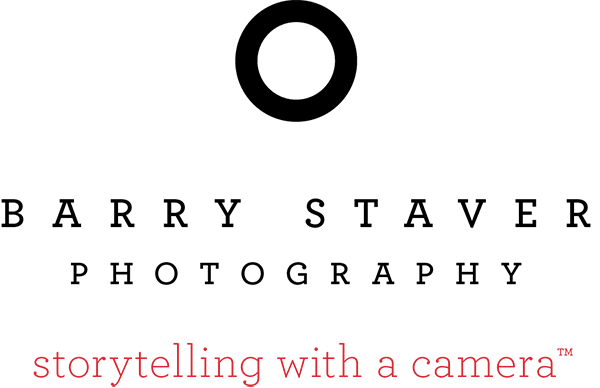
Use of a telephoto lens with aperture set wide open (f/2.8) takes your eye to the center of attention – man rolling the rug.
Both of the photographs on my current postcard stand out for the same reason: they were shot wide open. This technique puts emphasis on one part of the image, thus drawing your eye directly to it.
As the “storyteller with a camera” it’s one way for me to tell you a visual story. In fact, clients have relied on Barry Staver Photography to tell these stories for decades. Even though light is THE key ingredient to making great images, “Shooting Wide Open” comes into play at a strong 2nd place for successful photography. This phrase is but one of many used to describe the technique of having only 1 portion of the photograph in sharp focus while everything else is out-of-focus. “Depth of Field” is the traditional term used and shallow depth of field refines that a bit.
By only focusing sharply on the man, letting the foreground fall out of focus, the viewer’s eye is led up the hallway to the main subject. Had all of the rug, with it’s busy pattern, been in focus the impact of the photograph would be greatly diminished. Two other factors contribute to the success of the photograph, in my opinion. First is the lighting. I came upon this scene in The Penrose House while on assignment for the El Pomar Foundation. Not wanting to interrupt the work, I began to photograph the rug rolling in the darkened hallway. Not much of a photograph UNTIL light from an open doorway at left brought life to the scene. Notice how this light is also reflecting off of the wall on the right.
This wonderful light has illuminated our subject perfectly. The foreground remains dark which also helps focus our attention to the center of the frame.
The second bonus comes from the candid nature of the photograph. It’s not posed, I didn’t stop work or ask anything of our subject. There were only a few seconds to get the best shot while he was being lit by the doorway. Notice the motion blur of his left hand and arm as he lifts the rug. It adds just a bit of action to the scene. Real work if you will.

Tight focus on the glasses with a telephoto lens set “wide open”.
The second example of shallow depth of field captures the concentration in a board of directors meeting. The only thing in super sharp focus is the edge of her glasses. Her hand and the pencil in the foreground and the paperwork on the table are out of focus. Doesn’t your eye go straight to the glasses? Does it make you wonder what’s going on in the shot? What’s she pondering?
By using a telephoto lens I was able to shoot from a distance, not interrupting the meeting.








